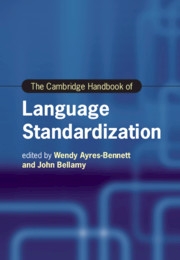Book contents
- The Cambridge Handbook of Language Standardization
- cambridge handbooks in language and linguistics
- The Cambridge Handbook of Language Standardization
- Copyright page
- Contents
- Figures
- Tables
- Contributors
- Introduction
- Part I Revisiting Models and Theories of Language Standardization
- 1 Modelling Language Standardization
- 2 Language Standardization ‘from Above’
- 3 Language Standardization in a View ‘from Below’
- 4 Social Cohesion and Emerging Standards of Hindi in a Multilingual Context
- 5 Standardization in Highly Multilingual National Contexts
- 6 Standardization of Minority Languages
- Part II Legitimacy, Authority and the Written Form
- Part III Norms, Literacy and Education
- Part IV Beyond the National
- Part V Standardization in Late Modernity
- Name Index
- Subject Index
- References
3 - Language Standardization in a View ‘from Below’
from Part I - Revisiting Models and Theories of Language Standardization
Published online by Cambridge University Press: 01 July 2021
- The Cambridge Handbook of Language Standardization
- cambridge handbooks in language and linguistics
- The Cambridge Handbook of Language Standardization
- Copyright page
- Contents
- Figures
- Tables
- Contributors
- Introduction
- Part I Revisiting Models and Theories of Language Standardization
- 1 Modelling Language Standardization
- 2 Language Standardization ‘from Above’
- 3 Language Standardization in a View ‘from Below’
- 4 Social Cohesion and Emerging Standards of Hindi in a Multilingual Context
- 5 Standardization in Highly Multilingual National Contexts
- 6 Standardization of Minority Languages
- Part II Legitimacy, Authority and the Written Form
- Part III Norms, Literacy and Education
- Part IV Beyond the National
- Part V Standardization in Late Modernity
- Name Index
- Subject Index
- References
Summary
Most accounts of histories of linguistic standardization have in common a focus on printed, formal or literary texts from writing elites. In recent historical sociolinguistic research, the question has arisen as to which texts ‘from below’ (i.e. informal and mostly handwritten texts, particularly from the lower ranks of society) contributed to the standardization processes of modern languages. Such texts have been handed down in Western languages since the beginning of the standardization era, but have been largely neglected or even ignored in conventional language historiographies. This chapter will set out with a critical review of traditional histories and current models of language standardization, in particular the four-step model by Haugen, which will be contrasted with an alternative model based on the ‘language history from below’ approach. It will then reflect on methodological aspects. One central question is that of adequate corpora (i.e. which texts and which text editions by which authors were and could be selected for the description of standardization processes). The last part of the chapter will present findings of case studies in recent research in (historical) sociolinguistics on standardization in a view ‘from below’.
- Type
- Chapter
- Information
- The Cambridge Handbook of Language Standardization , pp. 93 - 114Publisher: Cambridge University PressPrint publication year: 2021
References
- 6
- Cited by



